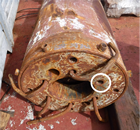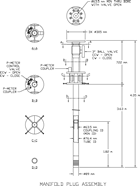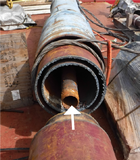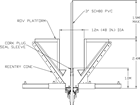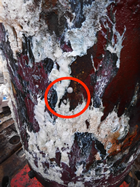Fryer, P., Wheat, C.G., Williams, T., and the Expedition 366 Scientists
Proceedings of the International Ocean Discovery Program Volume 366
publications.iodp.org
https://doi.org/10.14379/iodp.proc.366.103.2018
Site 12001
P. Fryer, C.G. Wheat, T. Williams, E. Albers, B. Bekins, B.P.R. Debret, J. Deng, Y. Dong, P. Eickenbusch, E.A. Frery, Y. Ichiyama, K. Johnson, R.M. Johnston, R.T. Kevorkian, W. Kurz, V. Magalhaes, S.S. Mantovanelli, W. Menapace, C.D. Menzies, K. Michibayashi, C.L. Moyer, K.K. Mullane, J.-W. Park, R.E. Price, J.G. Ryan, J.W. Shervais, O.J. Sissmann, S. Suzuki, K. Takai, B. Walter, and R. Zhang2
Keywords: International Ocean Discovery Program, IODP, JOIDES Resolution, Expedition 366, Site 1200, Site U1491, Site U1492, Site U1493, Site U1494, Site U1495, Site U1496, Site U1497, Site U1498, Mariana, Asùt Tesoru Seamount, Conical Seamount, Fantangisña Seamount, South Chamorro Seamount, Yinazao Seamount, Cretaceous seamount, subduction, subduction channel, forearc, seismogenic zone, mud volcano, fluid discharge, serpentinite, carbonate, harzburgite, clasts, ultramafic rock, breccia, gypsum, mudstone, chert, reef limestone, volcanic ash, guyot, CORK, CORK-Lite, screened casing
MS 366-103: Published 7 February 2018
Site summary
Ocean Drilling Program (ODP) Site 1200 is located on the summit of South Chamorro Seamount at 13°47.07′N, 146°0.17′E, in 2932 m water depth. In March 2001 during ODP Leg 195, six holes were drilled at this site and a borehole observatory (CORK) was installed in Hole 1200C. The objective of revisiting Hole 1200C during International Ocean Discovery Program (IODP) Expedition 366 was to remove the CORK body and leave the casing ready for a future expedition to install a more modern CORK observatory, termed CORK-Lite.
The newly opened casing could have supported a range of sensors, samplers, and experiments and allowed a network of experiments to be conducted at the seafloor with the borehole either sealed or open to formation discharge. However, during the attempt to remove the CORK, the latch rods failed to remove the portion of the CORK that latches into the casing hanger, forming a seal and focusing discharge up a steel pipe that contains the seal sleeve. This steel pipe parted above the seal sleeve where it was tack welded to an identically sized pipe that extended to the top of the CORK. Based on visual observations of the reentry cone and dissection of the lower potion of the CORK body, which was recovered, the CORK is likely sealed with access to the casing via a portion of a polyvinyl chloride (PVC) insert deployed in 2009. White and reddish material on the outside of the CORK body was collected for microbial and mineralogical analyses. About seven limpets were recovered from the CORK body and preserved for shore-based identification.
Background and objectives
South Chamorro Seamount, one of 16 large (as much as 50 km in diameter and 2 km high) active serpentinite mud volcanoes on the Mariana forearc (Fryer, 1996, 2012), is located about 78 km from the trench (see Figure F1 in the Expedition 366 summary chapter [Fryer et al., 2018]). It is primarily composed of unconsolidated flows of serpentinite mud with clasts consisting dominantly of serpentinized mantle peridotite, but it also includes clasts that contain fragments of metamorphosed basalts (metabasalt) ranging from greenschist to blueschist facies (Shipboard Scientific Party, 2002). The summit of the seamount shows active fluid seepage of slab-derived fluids with megafaunal assemblages that include mussels, gastropods, worm tubes, and galatheid crabs (Fryer and Mottl, 1997). Subsurface fauna include Archaea (Mottl et al., 2003; Curtis et al., 2013) and Bacteria (Takai et al., 2005). Even with evidence for fluid flow from a deep source (Hulme et al., 2010), temperatures measured in the uppermost meter at Site 1200 are between 2° and 3°C, which is just above the bottom water temperature of 1.7°C. Measured heat flow near active sites of seepage averages 15 mW/m2, and in the zone of maximum seepage, the heat flow is 101 mW/m2 (Shipboard Scientific Party, 2002).
During Leg 195, a series of boreholes was drilled on South Chamorro Seamount to recover material and install a borehole observatory (CORK) (Davis et al., 1992). The latter was undertaken to assess temporal physical, chemical, and biological processes associated with active serpentinite mud volcanism. Because the decision to drill this site was made ~6 months before the ship was scheduled to sail from Guam, it was only possible to deploy an original-style CORK using spare equipment from ODP Leg 168. The CORK was deployed in Hole 1200C, which was drilled to 266 meters below seafloor (mbsf). Hole instabilities prevented reaching this depth with casing, but the final configuration of the casing set the casing shoe at 202.8 mbsf with a screened section from 148.8 to 202.3 mbsf. This screened section provides a conduit for formation fluids at depth to exchange with fluids within the borehole. Thus, these deep-seated fluids can be sampled within the protective environment of the casing/CORK.
In March 2003, the remotely operated vehicle (ROV) Jason II recovered borehole instruments deployed during Leg 195. The screened portion of the casing within the borehole tapped a highly permeable zone; therefore, when borehole instruments were recovered, fluids from depth ascended the borehole and discharged at the seafloor, resulting in precipitation of brucite within the upper part of the borehole. Discharging fluids were collected, and measurements were made to assess fluid flow rates from the borehole (Wheat et al., 2008). Additional fluid sampling was conducted in 2009. However, there were issues related to latches within the CORK body and limitations imposed by the small diameter of the hole in the CORK structure. This hole is about 9 cm in diameter and constrains the size and shape of potential experiments and sensors that can be placed into the borehole.
Given these limitations to the original-style CORK in Hole 1200C, the plan for Expedition 366 was to remove the CORK body and leave the hole open for a future ROV deployment of a CORK-Lite (Wheat et al., 2012). A CORK-Lite allows for a modular design, including multiple ports for experiments and sensors outside of the CORK body, which can access fluid from the formation and allow for large-diameter (25 cm) experiments and sensors to be deployed within the borehole. The borehole can be either sealed or allowed to discharge. Such capabilities would serve a range of scientific interests for future studies. Additionally, after removing the CORK body, the plan was to reenter the borehole during Expedition 366 while deploying a new ROV platform. This would have permitted collection of borehole (formation) fluids and temperature measurements to assess temporal changes in fluid composition and discharge and collection of a dissolved gas sample that would not be affected by sampling artifacts associated with the typical recovery of unconsolidated material from coring operations.
Operations
Guam port call
Expedition 366 officially began with the first line ashore Dock F-3 in Guam at 0648 h on 8 December 2016. Critical items for the port call were to complete the change out of the top drive motor, which failed on the last site of the previous expedition, and replace the cryogenic magnetometer, which required JOIDES Resolution Science Operator (JRSO) technical staff with third-party support from 2G Enterprises. Items loaded on the ship included 1000 metric tons of marine gas oil; 20 metric tons of barite and 20 metric tons of sepiolite drilling mud via local P-trucks; 58 joints (3 flats) of 10¾ inch, 40.5 lb/ft buttress casing; two Baker-Hughes-Inteq drilling motors; two HOC DTU950 underreamers, and three standard reentry cones. Refrigerated containers carrying nearly 7 km of IODP Expedition 363 cores were dispatched to the Kochi Core Center in Japan, and returning surface freight was dispatched, including the rental mud motor, an HOC DTU950 underreamer for refurbishment, and other miscellaneous freight. Originally, the JOIDES Resolution was scheduled to depart at 0700 h on Tuesday, 13 December. However, due to military operations taking place in the area that morning, the decision was made with the pilot to depart at 0500 h.
Transit to Site 1200
The last line was cast off at 0518 h on 13 December 2016. The transit proceeded without incident. The ship arrived at Site 1200 at 1624 h the same day.
CORK recovery operations
Planned operations in Hole 1200C were to remove the currently installed CORK and ROV platform, install a new ROV platform, and deploy the water-sampling temperature probe (WSTP) within the cased drill string to the depth of the screened portion of the cased hole to collect pristine formation fluid and measure temperature for calculating the natural rate of fluid discharge from the borehole. This CORK was originally installed during Leg 195 in 2001 and is one of the original-style, latched-in varieties. This CORK was a backup system for Leg 168 on the eastern flank of the Juan de Fuca Ridge. The operations report from Leg 195 states that the casing hanger was landed and the latch engagement was verified (Shipboard Scientific Party, 2002). A problem with recovering these original-style CORKs is the failure of the latch rods, which are designed to release the latch dogs and allow the CORK to be retrieved, because corrosion renders them nonfunctional.
The recovery attempt began at 0500 h on 14 December 2016, utilizing the vibration isolated television (VIT) subsurface camera system to locate the CORK (Table T1). Several near misses occurred when the tool appeared to go over the top of the CORK head, but the pipe heaved off before the J-slots were fully engaged. After 5.25 h, the CORK head was engaged and the recovery tool J-slots were fully engaged. A slight amount of torque was applied from the top drive (approximately 100–150 A) to ensure that the J-dogs remained engaged, causing the overshot recovery tool to rotate. It was not obvious, but at some point the CORK head parted. Less than 10,000 pounds of overpull was applied, and it is not clear what role the torque and heave had in this event. Nevertheless, the failure occurred at the latch assembly and not from corrosion, based on the base of the portion that was recovered (Figure F1). It appeared that the latch rods were engaged, and five of the six rods were recovered. Note that some bending of these rods occurred during recovery when the overshot tool could not be removed and the CORK body was placed on the rig floor for stabilization.
Table T1. Hole 1200C summary. Download table in CSV format. View PDF table.
Video imagery from above the reentry cone after removal showed a small diameter tube protruding from the center of the reentry cone (Figure F2). This tube was interpreted to be a piece of schedule 80 PVC tubing that was installed in the CORK via ROV operations in 2009 after the original thermistor string was recovered in 2003. This PVC tubing was part of an assembly deployed within the CORK to provide pristine formation fluids at the surface by sealing the CORK with O-ring seals on the PVC pipe at the CORK seal sleeve (Figure F3). This prevented mixing of seawater within the upper portion of the CORK body either from the seal sleeve or the dogs where the original data logger was latched. Later in 2009, the insert was broken off ~75 cm from the top (between lines C and D in Figure F3), leaving a section of about 3.6 m of schedule 80 PVC pipe in the CORK. This PVC tube acted as a direct conduit for fluids to discharge without mixing with bottom seawater. The high-resolution camera with the new upgraded pan, tilt, and zoom capability was critical for the CORK recovery and assessment. The plume of material from the base of the reentry cone obscured visibility; thus, we were unable to observe the white particulates in the water column from the discharge of formation fluids into and reaction with seawater that were observed in 2003 and 2009. To confirm that the pipe in Figure F2 was indeed the PVC that had been inserted in 2009, we cut off the bottom of the CORK body after recovery and inspected the inside of the 5.25 inch outer diameter (OD) pipe of the CORK data logger seal sleeve (part Number OJ6038; minimum inner diameter [ID] of 3.5 inches). There was no PVC pipe in the recovered CORK body (Figure F4). Thus, the current state of the CORK includes the schedule 80 PVC pipe in the CORK seal sleeve, and it appears to rise above the ROV platform (Figures F2, F5). (The initial CORK was part Number OJ6100. Parts list for the original CORK: CORK Plug Seal Sleeve [OJ6038], Upper Mandrel [OJ6039; the threaded pin end is broken off in the seal sleeve], ROV platform [OJ6067], reentry cone [OH7006], landing ring [OH4722], 16 inch casing hanger [OH3750], and 10.75 inch casing hanger [OH3850].) In its current configuration, it is likely that pristine formation fluid continues to discharge from the PVC pipe, as it did before Expedition 366 operations commenced.
At 1615 h, the recovery tool with the recovered portion of the CORK returned to the rig floor. Science party microbiologists and geochemists sampled limpets, which may be a newly discovered species, and reddish and white precipitates from the CORK head (Figure F6).
Because the original CORK platform was not recovered and the lower portion of the CORK remains in the hole, replacement of the ROV landing platform and deployment of the WSTP tool did not occur. The VIT and drill string were recovered by 2112 h on 15 December, and preparations were made to transit to Site U1492.
References
Curtis, A.C., Wheat, C.G., Fryer, P., and Moyer, C.L., 2013. Mariana forearc serpentinite mud volcanoes harbor novel communities of extremophilic Archaea. Geomicrobiology Journal, 30(5):430–441. http://dx.doi.org/10.1080/01490451.2012.705226
Davis, E.E., Becker, K., Pettigrew, T., Carson, B., and MacDonald, R., 1992. CORK: a hydrologic seal and downhole observatory for deep-ocean boreholes. In Davis, E.E., Mottl, M.J., Fisher, A.T., et al., Proceedings of the Ocean Drilling Program, Initial Reports, 139: College Station, TX (Ocean Drilling Program), 43–53. http://dx.doi.org/10.2973/odp.proc.ir.139.103.1992
Fryer, P., 1996. Evolution of the Mariana convergent plate margin system. Reviews of Geophysics, 34(1):89–125. http://dx.doi.org/10.1029/95RG03476
Fryer, P., 2012. Serpentinite mud volcanism: observations, processes, and implications. Annual Review of Marine Science, 4(1):345–373. http://dx.doi.org/10.1146/annurev-marine-120710-100922
Fryer, P., and Mottl, M., 1997. Shinkai 6500 investigations of a resurgent mud volcano on the southeastern Mariana forearc. JAMSTEC Journal of Deep Sea Research, 13:103–114. http://www.godac.jamstec.go.jp/catalog/data/doc_catalog/media/shinkai13_09.pdf
Fryer, P., Wheat, C.G., Williams, T., Albers, E., Bekins, B., Debret, B.P.R., Deng, J., Dong, Y., Eickenbusch, P., Frery, E.A., Ichiyama, Y., Johnson, K., Johnston, R.M., Kevorkian, R.T., Kurz, W., Magalhaes, V., Mantovanelli, S.S., Menapace, W., Menzies, C.D., Michibayashi, K., Moyer, C.L., Mullane, K.K., Park, J.-W., Price, R.E., Ryan, J.G., Shervais, J.W., Sissmann, O.J., Suzuki, S., Takai, K., Walter, B., and Zhang, R., 2018. Expedition 366 summary. In Fryer, P., Wheat, C.G., Williams, T., and the Expedition 366 Scientists, Mariana Convergent Margin and South Chamorro Seamount. Proceedings of the International Ocean Discovery Program, 366: College Station, TX (International Ocean Discovery Program). https://doi.org/10.14379/iodp.proc.366.101.2018
Hulme, S.M., Wheat, C.G., Fryer, P., and Mottl, M.J., 2010. Pore water chemistry of the Mariana serpentinite mud volcanoes: a window to the seismogenic zone. Geochemistry, Geophysics, Geosystems, 11(1):Q01X09. http://dx.doi.org/10.1029/2009GC002674
Mottl, M.J., Komor, S.C., Fryer, P., and Moyer, C.L., 2003. Deep-slab fluids fuel extremophilic Archaea on a Mariana forearc serpentinite mud volcano: Ocean Drilling Program Leg 195. Geochemistry, Geophysics, Geosystems, 4:9009. http://dx.doi.org/10.1029/2003GC000588
Shipboard Scientific Party, 2002. Site 1200. In Salisbury, M.H., Shinohara, M., Richter, C., et al., Proceedings of the Ocean Drilling Program, Initial Reports, 195: College Station, TX (Ocean Drilling Program), 1–173. https://doi.org/10.2973/odp.proc.ir.195.103.2002
Takai, K., Moyer, C.L., Miyazaki, M., Nogi, Y., Hirayama, H., Nealson, K.H., and Horikoshi, K., 2005. Marinobacter alkaliphilus sp. nov., a novel alkaliphilic bacterium isolated from subseafloor alkaline serpentine mud from Ocean Drilling Program Site 1200 at South Chamorro Seamount, Mariana forearc. Extremophiles, 9(1):17–27. http://dx.doi.org/10.1007/s00792-004-0416-1
Wheat, C.G., Edwards, K.J., Pettigrew, T., Jannasch, H.W., Becker, K., Davis, E.E., Villinger, H., and Bach, W., 2012. CORK-Lite: bringing legacy boreholes back to life. Scientific Drilling, 14:39–43. http://dx.doi.org/10.2204/iodp.sd.14.05.2012
Wheat, C.G., Fryer, P., Fisher, A.T., Hulme, S., Jannasch, H., Mottl, M.J., and Becker, K., 2008. Borehole observations of fluid flow from South Chamorro Seamount, an active serpentinite mud volcano in the Mariana forearc. Earth and Planetary Science Letters, 267(3–4):401–409. http://dx.doi.org/10.1016/j.epsl.2007.11.057
1 Fryer, P., Wheat, C.G., Williams, T., Albers, E., Bekins, B., Debret, B.P.R., Deng, J., Dong, Y., Eickenbusch, P., Frery, E.A., Ichiyama, Y., Johnson, K., Johnston, R.M., Kevorkian, R.T., Kurz, W., Magalhaes, V., Mantovanelli, S.S., Menapace, W., Menzies, C.D., Michibayashi, K., Moyer, C.L., Mullane, K.K., Park, J.-W., Price, R.E., Ryan, J.G., Shervais, J.W., Sissmann, O.J., Suzuki, S., Takai, K., Walter, B., and Zhang, R., 2018. Site 1200. In Fryer, P., Wheat, C.G., Williams, T., and the Expedition 366 Scientists, Mariana Convergent Margin and South Chamorro Seamount. Proceedings of the International Ocean Discovery Program, 366: College Station, TX (International Ocean Discovery Program). https://doi.org/10.14379/iodp.proc.366.103.2018
2 Expedition 366 Scientists’ addresses.
This work is distributed under the Creative Commons Attribution 4.0 International (CC BY 4.0) license. 
